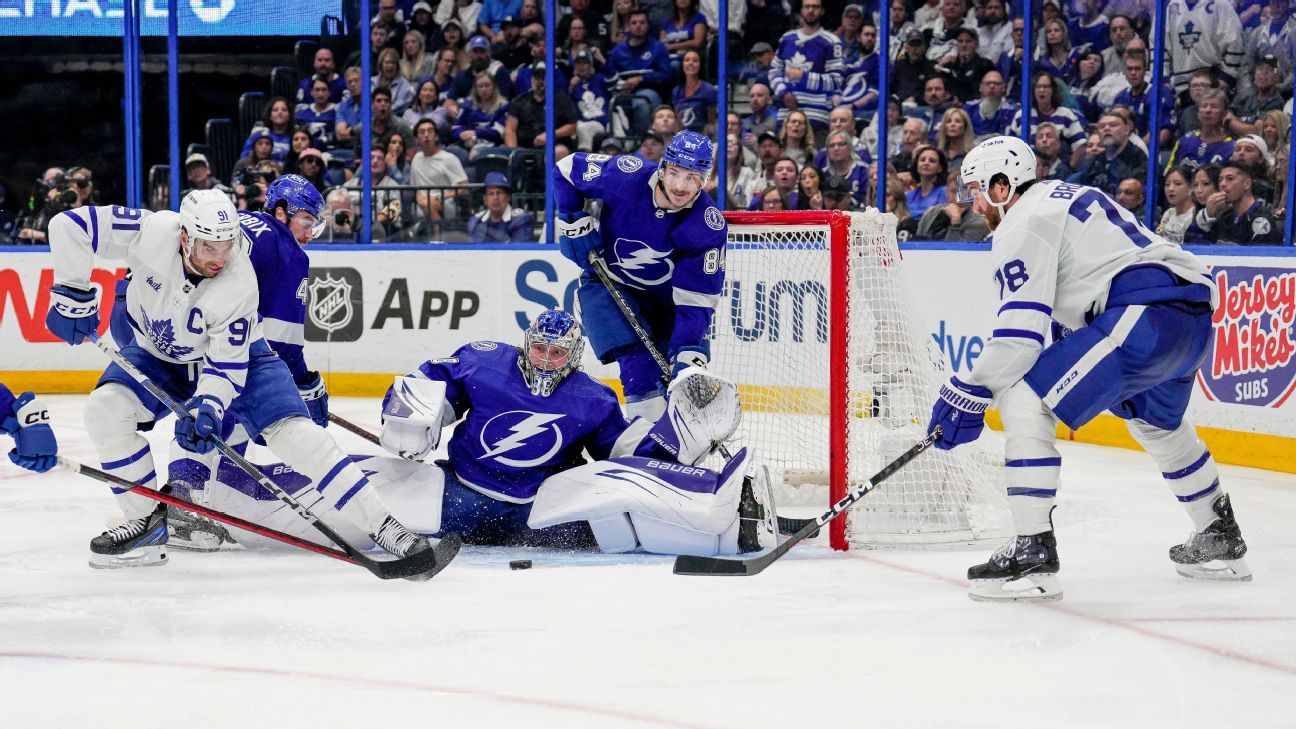
It started as a series of blowouts. It became a matchup defined by comebacks.
What’s remained the same throughout is that the
The playoffs are here. Get caught up on all the latest news and preview content:
• Schedule, scores, highlights
• Inside the Battle of the Hudson
• Wyshynski’s playoff bracket
• Top 50 players in the playoffs
• Updated series odds, Cup futures
• Subscribe to ESPN+
• Stream the NHL on ESPN
Bottom line? Like much of Tampa Bay’s lineup, its goaltender hasn’t been good enough. There’s no victory in sight for the Lightning if that doesn’t change.
“We scored enough goals to win,” Lightning coach Jon Cooper said following Tampa’s 5-4 loss in Game 4. “You’ve got to keep them out of your net.”
Fortunately for the Lightning, there’s a long history of Vasilevskiy doing just that. He entered this postseason with enviable stats, a 63-38-0 playoff record, including seven shutouts — six of which have come in elimination games.
Basically, Vasilevskiy has been the Lightning’s backbone with their season(s) on the line. Cooper pointed out that several of the goals Vasilevskiy allowed late in Game 4 were tips and deflections, strikes that any goaltender — even ones who have won the Vezina Trophy, Conn Smythe Trophy and Stanley Cup — would struggle to stop.
Vasilevskiy can’t undo what’s happened. But he can still be that clutch performer Tampa Bay has relied on for the past decade. And few things would get into Toronto’s heads quite like seeing Vasilevskiy go full-on shutdown mode with so much at stake.
Don’t deviate; elevate
The Leafs’ supposedly improved depth was a constant talking point heading into this series.
Lo and behold, the rumors were true. Toronto has graduated beyond just relying on its core of star players — namely Matthews, Mitch Marner and William Nylander — and has attacked the Lightning from all angles (and every line) throughout the past four games.
To date, the Leafs have had 10 different goal scorers, seen six players pass the six-point mark, and gotten key contributions from one rookie (Matthew Knies) and two trade-deadline acquisitions: Ryan O’Reilly, with seven points, and Noel Acciari with two goals.
The Leafs’ chemistry is palpable. The trick is not to overthink it.
Toronto already made one key decision in deciding not to insert Michael Bunting back into the lineup for Game 5. The feisty top-line forward was suspended three games for elbowing and interference against Tampa defenseman Erik Cernak in Game 1. He was eligible to return for Game 5, but Keefe said Wednesday that Bunting will remain on the bench.
Ultimately Keefe decided that, despite what Bunting brought to the team with a 49-point regular season effort, it wasn’t worth disrupting the group that has won three straight playoff games. Not that he’s afraid to move players around — at Wednesday’s practice, Knies had been elevated to the Leafs’ second line with Tavares and Marner.
That’s just a further example of how the Leafs can continue using all the players they have to keep Tampa Bay on its toes — and avoid their previous fate as a one-dimensional foe.
“[I like] the top-to-bottom six and that’s part of the decision to not insert Bunting in, [so we’re] maintaining that,” Keefe said. “We’re trying to establish something where we are comfortable playing all four lines. That was our intention going into the series. We thought we were in a good spot that way and had to adjust along the way, which is what we had to do the other night [in Game 4]. The players responded well, we can always make other adjustments if needed, but we like to group [this] way.”
Lightning need full team effort on defense
“In the end, you’ve got to defend,” Cooper noted after Game 4. “And you’ve got to keep the puck out of your net.”
That’s been easier said than done for Tampa Bay lately, but it has established the right blueprint of what not to do.
The primary problem is that Tampa Bay’s blueline isn’t the same without Cernak. He’s been absent since the Game 1 hit by Bunting, and he won’t be dressing for Game 5, either.
Victor Hedman missed time early in the series because of an injury and is likely not at 100%. Mikhail Sergachev has been banged up and briefly left Game 4 after blocking a shot from O’Reilly. The Lightning are leaning on rookies Darren Raddysh and Nick Perbix to play critical minutes, and they’ve delivered admirably. What Tampa Bay truly requires, though, is more defensive buy-in across the board.
“In the totality of things, would we like to have Cernak in our lineup, a top-four defenseman for us? Yes,” Cooper said. “[But] we’ve gotten in our own way, obviously, at some of these points.”
Toronto learned the hard way in Game 1’s disastrous 7-3 loss that if it didn’t start wrapping up the Lightning’s top-flight forwards in front of the net and stopping them from setting up a strong cycle, it was about to be a short series. Tampa Bay must make the same investment in its end.
Instead of leaving Vasilevskiy out to dry, it’s on Tampa Bay’s entire five-man units to be pressuring Leafs’ skaters to the outside and not allowing them to set up in front. Pushing shots through traffic is how Toronto worked its way back in Game 4, and a tighter effort from the Lightning — particularly through the neutral zone — won’t allow the Leafs those opportunities to get in Vasilevskiy’s line of vision.
Cooper admitted his team might have sat back in the third period of that Game 4 loss. There’s nothing like the threat of impending elimination to light a fire under any player — regardless of superstar status — to do the dirty work necessary that keeps a team’s hopes alive for a Game 6.
Wanted: Perked-up PKs
Special teams play an important role in every postseason series.
The charitable thing to say is that Tampa Bay and Toronto have been equally good in this one on the power play. Another reality is that, at times, both teams’ penalty kills have been something of an eyesore.
Going into Game 5, Toronto is at 70.6% on the PK (and 6-for-17 on the power play).
Tampa Bay is even worse at 64.7% on the PK (and 5-for-17 on the power play).
Will this all-important, potentially series-deciding Game 5 be determined by whose penalty kill is less awful?
The Lightning penalty kill gave up a game-winning power-play goal to Alexander Kerfoot in Game 4. Toronto’s kill has been discombobulated at times by Tampa Bay’s four-forward look on the man advantage (see: allowing four power-play markers in Game 1).
Staying out of the box would help, obviously. Tampa Bay has taken more penalties (27) than any team in the postseason. The Leafs aren’t far behind with 23 infractions.
There have been heroic short-handed moments from both sides, too. Key shot blocks. Dives into shooting lanes. Aggressive pressure and positive results.
It’s just takes one bad decision, though. One careless clear or sloppy turnover when you’re down a man and it won’t be even-strength play that rules the day. That can be a tough pill to swallow with results on the line.













